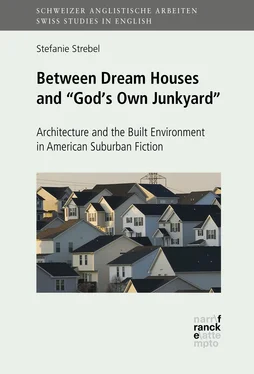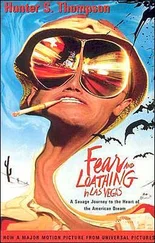Corresponding to the status of the suburban sphere of London prior to the Industrial Revolution, one of the earliest definitions of the term “suburb” – in use from the fourteenth to the mid-eighteenth century – is “a place of inferior, debased and especially licentious habits of life” (qtd. in Fishman, Bourgeois Utopias 6). Evidently, the public attitude towards this environment – in the United States much more so than in other countries – has changed drastically since then. According to Fishman (“Rise and Fall” 14), this shift in thinking initially had a close connection to Evangelical Protestantism in England, in the context of which the pleasures offered by the city became disreputable and were regarded as decadent. This fall from grace of the cities was favourable for the urban periphery, and even more so for rural areas back then. Now that the dichotomy between city and suburb is considerably less defined and boundaries are increasingly blurred, public perceptions and opinions regarding city and suburbia have shifted again. It is particularly since the late twentieth century, with the increasing visibility of urban sprawl and its impact on the environment, that American suburbia has come under renewed and reinforced scrutiny and has received its fair share of criticism. However, this circumstance did not necessarily lead to a reconsideration of the city as a better place to live, although there has been a trend for younger people to move back to urban areas in recent years. It is rather the case that there seems to be no residential utopia, and no ideal to aspire to anymore.
In addition to the fact that the American suburb is criticised as a concept, this criticism is itself criticised for being fashionable, and the accusations are sometimes considered superficial and ill-founded in their argumentation. It is often argued that it is simply fashionable to bring the suburbs into disrepute, especially among young people and intellectuals. As Hitchens (122) observes, anything suburban is continuously and sternly disapproved of by the country’s intellectuals, and along with the bohemian urban sphere, they would also rather choose the “idiocy” of rural life than move to the suburbs. Considering the wealth of publications, both literary and cinematic ones, which portray suburbia in a negative light, it cannot be denied that badmouthing this sphere is indeed fashionable. However, as already pointed out, whether it is justified to target suburbia with such vast amounts of negativity is a matter of dispute, not least a political one between conservatives, who tend to condemn the criticism, and liberals, who tend to criticise.
The Suburb in Popular Culture
All criticism aside, the suburb in the United States, which for a long time was merely a marginal phenomenon with limited cultural significance, is now the core, or the essence of the country’s society and ideology. As Coon (4) underlines, “[u]nderstanding American suburbia is an essential step toward understanding American culture.” Millard (220), too, points out that “[a]ny serious understanding of the individual and collective behavior of Americans requires a deep, nuanced understanding of suburban mindsets,” since “suburban ways of life have distinct consequences for practically every important aspect of a civilization: energy use, economic variables, sociopolitical attitudes, [and] cultural formations.”
The current cultural and political significance of the suburbs is especially impressive when considering the short time in which they evolved. It has been less than one hundred years since the outskirts began to flourish significantly and gain more influence. Until the 1920s, it was the city that exercised power in cultural and political domains, but since then, many urban centres have found themselves in an increasing state of decay, and their significance has diminished greatly. In political terms, it was especially in the 1996 election, with Bill Clinton and Bob Dole running for president, that due to the candidates’ heavy campaigning in suburbia, the loss of power of the city centres became apparent. As G. Scott Thomas (9) observes, “[t]he 1996 campaign, if nothing else, proved that cities are no longer strong enough to dictate national policy […]. Power has shifted to the smaller, quieter communities lying beyond the city limits. The United States has entered the Suburban Age.” Stilgoe, too, sees the suburbs as the driving force behind political decisions, and additionally notes that they are now also considered the hotspots of other cultural and economic domains:
Suburbs control state and national elections, suburbs consume the bulk of manufactured goods, suburbs sprawl across vast areas that defy traditional political nomenclature or topographical analysis. If opinion polls prove accurate, suburbs represent the good life, the life of the dream, the dream of happiness in a single-family house in an attractive, congenial community that inspires so many urban apartment and condominium dwellers to work, to save, to get out of cities they perceive as chaotic, inimical to childhood joy, unnaturally paced, incredibly polluted, and just too crowded. Suburbs now set standards – standards as simple as the “proper” sort and amount of domestic indoor space and as complex as the naturalness of a contrived forest – by which a majority of Americans judge cities and find them wanting. (Stilgoe 2)
There is no denying that in many metropolitan areas of the United States, life now happens in the suburbs. People cling to the suburban dream and often voice great satisfaction with their living environment despite the vast array of criticism targeted at it, and due to its perpetual appeal and ensuing ever-growing population, American suburbia remains in control of national politics.
Regardless of the seemingly happy suburbanites, and corresponding to their negative reception by critics, in popular culture, the suburbs have been portrayed in a predominantly adverse light in their various representations. As mentioned already, works of fiction set in this environment have a strong tendency to echo the critical attitude that was and still is voiced by intellectuals primarily, with authors heavily emphasising the idea of crumbling values and the general disillusionment this artificially created landscape has caused over the decades. While it used to be the American inner-city neighbourhoods that had a particularly bad reputation when it comes to decaying social and moral values, people have realised that suburbia is not exempt from decadence, and that it may in fact contribute greatly to the loss of social coherence.
This increasingly critical attitude does not change the fact that the suburbs remain the preferred living environment for the average American citizen, however, and that they thus have an enormous impact on politics as well as on cultural concerns. “The Suburbs Have Won” is the title of a 1997 article by Nicholas Lemann published in the online magazine Slate , in which the author describes how the urban periphery dominates both everyday life and popular culture in America. When considering the plethora of books, films, television series and songs that are based on suburban life, Lemann certainly has a point in acknowledging the victory and triumph of this sphere. Television series that take place in and are defined by a suburban setting have had a longstanding tradition in the United States, which is certainly owing to the fact that these shows are family-centred – and families, in the ideally shaped and stereotypical self-image of Americans, live in suburbia. This scenario is what the average audience can identify with since it represents their living environment in a more dramatic and embroidered version – a more exciting, a more interesting interpretation of their existence which nonetheless remains relatable.
Читать дальше











